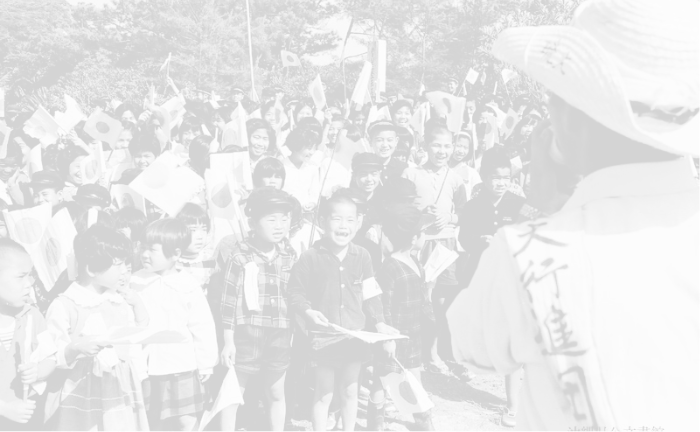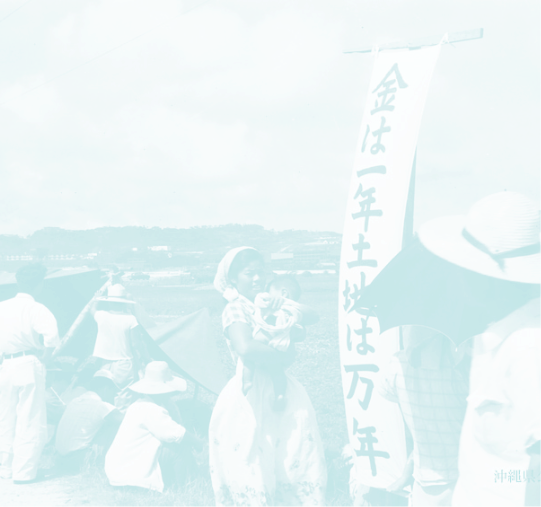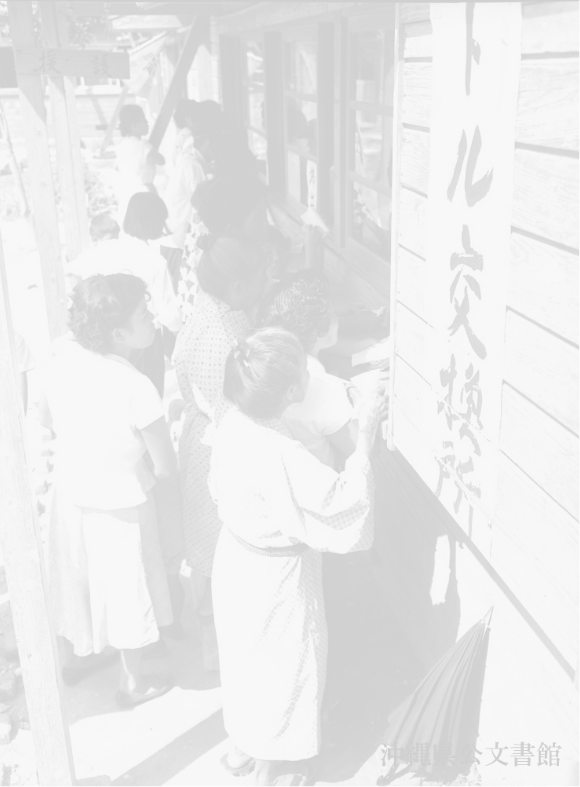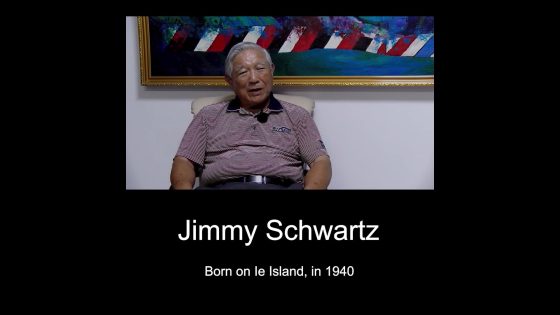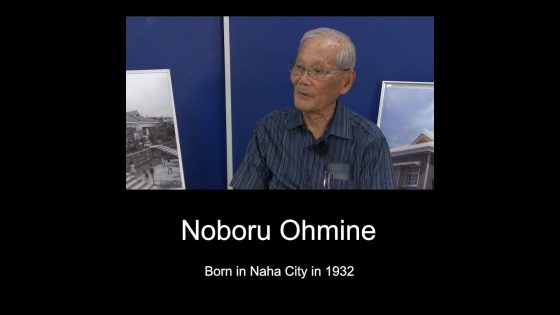
Thinking about Peace and Culture from Yaima


- Born in 1937
- Setsuko Yamazato
Timeline
| 1937 |
Born in Tonoshiro, Ishigaki Island.
|
|
|---|---|---|
| 1945 |
Experienced the war on Ishigaki Island and contracted malaria in a hut on the island. During the war, he lost four of his eight family members, including his mother and grandfather.
|
|
| 1945 |
The United States conducted a comprehensive research of Okinawa Island.
|
|
| 1952 |
The Yaeyama Ryukyuan-American Cultural Center is established by the United States Civil Administration of the Ryukyu Islands.
|
|
| 1955 |
Worked as an assistant to geologist Dr. Helen Foster on a U.S. geological survey.
|
|
| 1956 |
Worked at the US Army Far East Map Bureau in Oji, Tokyo, participate in the survey team's report, checking place names and proper nouns.
|
|
| 1960 |
A military report based on comprehensive research report in Yaeyama was published in Washington.
|
|
| 1963 |
Worked at the Yaeyama Ryukyuan-American Cultural Center, teaching English conversation and other classes. Also worked on projects related to Yaeyama's performing arts and culture. (until 1969)
|
|
| 1985 |
Researchers of Okinawa's postwar history point out that the comprehensive U.S. research was intended for military use.
|
|
| 2016 |
Founded and served as president of Obaa-tachi no Kai (Grandmothers' Association for the Protection of Life and Livelihood).
|
Story
Brief biography of the witness
Studied English at the Yaeyama Ryukyuan-American Cultural Center while in high school. Worked as an assistant in a U.S. geological survey in the Yaeyama area. After working for a half-civilian, half-military airline and the Ryukyuan-American Cultural Center, she became involved in the peace and environmental movements in Okinawa. She is currently a staff member of Obaa-tachi no Kai (Grandmothers' Association for the Protection of Life and Livelihood).
Became assistant to the US research team
US Academic Research Team Visiting Yaeyama
Back then, I had dropped out of high school and was working at a small company. I had a desire to study English. At that time, the Yaeyama Ryukyuan-American Cultural Center offered various English programs. I went there to study English. One day, my teacher suddenly asked us to apply for an opportunity—a research team was scheduled to arrive on Ishigaki Island to conduct geological research, and the team's female leader was actively seeking an assistant. Intrigued by the prospect of acquiring practical English skills through work, five or six of us, including myself, decided to attend an interview. At that time, the Yaeyama Civil Administration Office, acting as the representative agency for the High Commissioner in Ishigaki and Miyako, provided office space for the research team during their research period. Our interview was with the team leader, Helen Foster. The first thing Helen said was, “Do you all know what geology is? “Everyone answered, “No. ”When she asked the second question about the job, everyone except me answered “No” but I said “I'd like to try it. ”The team that arrived on Ishigaki Island comprised two geologists, two soil scientists, and one specialist in vegetation ecology named Forsberg, who oversaw Ishigaki and Miyako Islands.
Accompanied the Geological Research as an Assistant
While the research period on Miyako, a flat island, was brief, the team remained on Ishigaki Island for nearly two years. Despite the overarching field being geology, the team focused specifically on structural geology. The task involved finding rock outcroppings, and walking along, tracing the boundaries between the rocks, irrespective of encountering roads or rivers. Sometimes when Dr. Foster wanted to sample rocks, we stopped, and broke the rock into pieces the size of a sweet potato with a hammer. We recorded the data and put the rock in a bag. Bags of rocks were put into my backpack one after another, so my backpack was digging into my shoulders by the evening. It weighed over 10kg. Those were the days we spent during the research period
Dr. Foster and Our Names for Each Other
We had a kind of island or national trait, so I wasn't used to people casually calling each other by their names, so I called her “Dr. Foster.”
After the Field Research
The field research began around June 1955, and we finished our research in October of the following year, after which I moved to Tokyo. There was a US military facility called the US Army Far East Map Bureau in Oji, Kita City, Tokyo, which became famous during the Vietnam War. During the Vietnam War, the research team rented a corner of the facility that was to become a field hospital, and created a report of the field research. Everyone created draft reports there and sent them all to the headquarters in Washington. The headquarters in Washington organized those reports. The counterparts with whom the military had contracted to conduct the research participated in this process and prepared reports that were applied to military applications based on the individual scientific research. While there was a set of purely scientific reports written by geologists and soil scientists, in contrast, there was a summarized military version of all these reports, and they were called “Geology of Ishigaki-shima, Ryukyu-retto” and “Military geology of Ishigaki-shima, Ryukyu-retto (Ⅰ) (Ⅱ)” These military reports were completed and published in Washington in 1960. The US military began various construction projects including ports on Ishigaki and Miyako Island in the following year of 1961. A considerable amount of reclamation was carried out at Ishigaki. To the south of the already-established areas of Tonoshiro, Okawa, Ishigaki, and Arakawa, there is Yashima Town, Misaki Town and Shinei Town, which were all reclaimed after the war. There is currently an artificial island near Yashima Town, but it was the US military that started building the first caisson (box-like structure) for it. The construction was carried out by the US military for about 11 to 12 years until 1972, the year of Okinawa's return to Japan. In the year of the return, it was transferred to the Japanese government and construction continued, resulting in the current situation.
Comprehensive Research in the US and Okinawa Main Island, Ishigaki, and Miyako
Comprehensive Research in the US and Okinawa Main Island, Ishigaki, and Miyako
This comprehensive research by the US was carried out on the main island of Okinawa over about five years starting from the year the war ended (1945.)Once that was completed, research was conducted at key locations where US forces were stationed, such as the Marshall Islands and Micronesia. It was said that the purpose of these research projects was military investigation. After five years of research, at the end of that period, a research team came to Ishigaki and Miyako. I wondered why, but now that I look back and think about it, the Korean War had just ended at that time, so I think that was the motivation for coming to Ishigaki and Miyako to conduct research.
Working in Tokyo after the Field Survey
I went to Tokyo from Ishigaki Island. A person who was an assistant to the head of the research team came from Miyako. Our main job in Tokyo (Far East Map Bureau) was checking place names and maps, and coloring maps. We checked unknown place names and proper nouns that only locals could read. As I mentioned earlier, there were two types of research reports: purely scientific reports and military reports that integrate the information. I have a copy of “Geology of Ishigaki” written by Helen. I received it as a keepsake, so I have kept it with me until now. In 1980, about 30 years after the research took place,
Research materials were used for military purposes
Mr. Masahide Ota and Mr. Etsujiro Miyagi (researchers of postwar Okinawan history) reported on matters related to the US research at a press conference. Mr. Ota said that the hard parts of the development projects in Okinawa after the return to Japan were based on data collected by the US military, and there was no doubt that the purpose was for military use since everything was developed based on this data. Furthermore, I was astonished to see the article stating that the issue of building an airport in Shiraho was no exception to this. At the time, I was involved in the movement against the construction of the new Ishigaki Airport in Shiraho, so I will never forget the shock I felt at that time. I did not know it but, because I had been serving the research team which came with the purpose of the militarization of Ishigaki Island by the US military, I felt a sense of redemption. I don't think I will be able to shake this feeling as long as I live.
During the war, I lost half of my family of eight. My motivation to learn English must have been created based on that experience, but when I learned a little bit of English and went out into the world, I found myself working in the exact opposite position of what I had intended. Currently, I am involved in activities such anti-war/peace and anti-military bases and I'm involved in the peace movement, but I always know in a corner of my mind that I can't shout and yell as loudly and proudly as others all do. That's why I'm always looking for ways to reflect my own experiences and use them as advantages in the peace movement in some way as I did during the campaign against Shiraho.
While working at Yaeyama Ryukyuan-American Cultural Center
As an Employee of the Ryukyuan-American Cultural Center
I started working at the Yaeyama Ryukyuan-American Cultural Center from the summer of 1963 to the end of 1969. The Ryukyuan-American Cultural Center had a planning department and library department. I worked as an administrator in the library department. I also had experience living in the US. Since it was the Ryukyuan-American Cultural Center, USCAR (United States Civil Administration of the Ryukyu Islands) put a lot of effort into English education for children and adults. I was in charge of English conversation classes for kindergarten students and adults. Apart from English classes, I could plan a program freely on my own.
I was interested in local dances and songs, so I talked to those people and we did some projects. One day, there were posters in the center saying “Don't come in wearing clogs” and “Don't go inside with barefoot. “That caught my eye, and I rebelled against it. I approached the locals who went out in the morning and returned from the fields at around 8 or 9 pm and were still unable to wash their hands and feet. Then, I incorporated the unique songs of the peasants into the repertoire of my projects at the Ryukyuan American Cultural Center. I think the only cultural facility in those days was the Ryukyuan-American Cultural Center. In that sense, it received a lot of attention from the citizens and feedback was given more than it should have been.
How to Approach Various Events
Staff and managers in the planning department and library department made annual plans. Annual events, monthly events, seasonal events, weekly events, and daily events were all planned in advance, and in accordance with these plans, instructional programs such as library club or reading club were run by the staff. There was no set plan for the planning department, and it was left up to the independence and creativity of the staff. Other than the English program, I think most of the staff were able to freely engage in art and other activities. For areas that were difficult for us to handle, we talked to ordinary citizens and we invited them as volunteer instructors. At that time, everyone volunteered very kindly and cooperatively, teaching dance, calligraphy, and tea ceremony. Saying, “It's natural that we should do what we can.”
Relationship with the US Civil Government
We sent reports to USCAR weekly. The Yaeyama Ryukyuan-American Cultural Center submitted requests to the Yaeyama Civil Administration Office once a week, rather than directly to USCAR. The civil administration office supplied and procured what was required to meet the requests. I have never felt constrained by the US side. It was not total freedom but I could basically do whatever I wanted. But they seemed to welcome Okinawan culture more than Japanese culture. The Center Director once mentioned this, saying “It's just a ploy by those people to separate Japan and Okinawa. “I was persuaded by this opinion, and I thought that it was someone who had read the intent behind it. It was a new insight.
When it came to the annual special event, the hall of the Cultural Center was filled with about 300 people. In this way, people in the local community could connect with each other. This was the greatest joy for me.
Local Performing Arts at the Cultural Center
Yaeyama has an event called Angama during Obon (an annual Buddhist event for commemorating one's ancestors.)I brought the Angama event to the stage of the Cultural Center. If you go to the remote islands of Yaeyama, during the three days of Obon, Angama visits every house and offers a memorial service. When I was a child, I asked my grandmother why Angama didn’t visit my house and she said that it’s impossible to invite Angama because we don't have money. That stayed in my head forever, I invited Angama once to the Cultural Center to please everyone who couldn't invite Angama to their place. In response to this, some people were extremely critical of the fact that the Angama for ancestor memorial services was held in the Cultural Center even though it’s a place without a Buddhist altar. But I carried out the event for those who could not invite Angama to their homes. That kind of freedom was allowed there. I thought that Ryukyuan and American culture had nothing to do with culture, so I wanted to enjoy the culture of Yaeyama. Until then, even if we knew that something was important to the island, there were people who had no idea how important it was or who didn't even know it. Particularly among those involved, people said things like “Why are you doing something like that at the Cultural Center?”
Message to younger generations
Message to younger generations
We are currently in between the generation that experienced war and the generation that does not know about it. In our case, war was nothing more than a childhood experience, but for those who experienced war, as long as they are alive, they will never experience an "end to war", or rather, they have come this far in that state. But wars are caused by humans. I think it is humans who start wars, and humans who can end them. In the midst of all this, just recently I was also told that the term Nansei Islands is a military term, which made me think again. We can be victims of wars that we do not even know we are involved in. Those who approve of war and those who deny it equally can be victims. I hope that young people will be aware of this and will always keep their antennae up and work hard to keep the peace in the unique environment of Okinawa, where they were born and raised.
